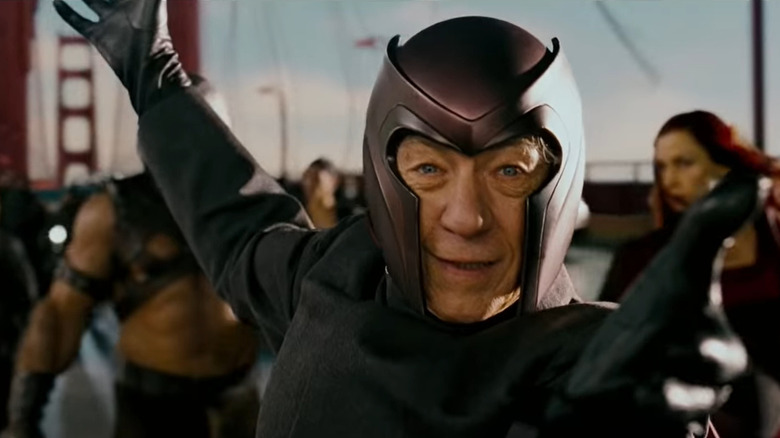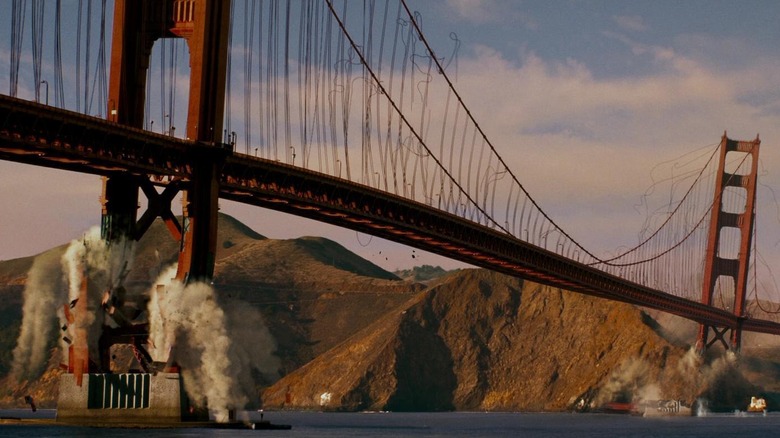Making Magneto Move A Bridge Nearly Broke X-Men: The Last Stand
"X-Men: The Last Stand" is not the most beloved movie in the "X-Men" franchise, in part because it's the movie that nearly killed it. Not only did it attempt to tackle the revered Dark Phoenix storyline from the comics, despite not having done much to develop Jean Gray as a character in the first two films, but it made the acclaimed comic saga the B-story of the movie. Meanwhile, the A-story was an interesting but half-baked storyline about a mutant "cure," one that had little connection with what was going on with Jean. The writers also decided to kill off major characters and sideline others, to the point where so much of what we'd come to love in the first two films were gone by the end of this one.
Despite its shortcomings, "X-Men: The Last Stand" may have been the most visually impressive of the 2000s "X-Men." The moment that particularly stands out is when Magneto (Ian McKellen) decides to lift up the Golden Gate Bridge and moves it to connect San Francisco to Alcatraz Island. It's a nonsensical moment that serves as a prime example of how the once complex and sympathetic villain Magneto has been flattened to a one-dimensional bad guy in this film. At the same time, it's a really cool sequence.
"It's such a crazy event, it should feel magical," effects supervisor John Bruno told Entertainment Weekly. Talking about the audience reactions at the Cannes premiere, he said, "When the bridge moved, they applauded. I looked around thinking, 'Are they laughing at us?' But no, they loved it."
The most expensive scene in the movie
"It's the first scene we started and the last one we finished," said Bruno. The scene took up an estimated sixth of the film's special effects budget, which is particularly impressive considering it's just a few minutes of a nearly two-hour film. In fact, the sequence was originally intended to be more complex, because Magneto was supposed to tear apart the bridge and create a new one. But the 10 months dedicated to making the scene work was nowhere near long enough for them to pull that off, so they settled for having Magneto "simply" lift the bridge and move it over to Alcatraz Island.
They also built a giant full-scale set of the bridge in Vancouver, which used 30 real cars, as well as a ton of CGI. According to Entertainment Weekly, the toughest images to do were "the long shots revealing the entire airborne bridge span, because of the complexity of the computer models required and how well the public knows what the real thing looks like."
Another challenge was the movie's attempts to avoid any comparisons to real-life disaster footage from the terrorist attacks of September 11, 2001. Bruno recalled, "The effects planners were also restricted in how close they could fly to the bridge in a helicopter to get reference footage, an especially sensitive matter post-9/11." Although Hollywood's hesitance around disaster movies died down by the mid-2000s, it was still important to film the scene in a way that didn't feel too real or too familiar to real-life events.
What they got was an exciting action sequence, one that was probably the most memorable part of the movie. "X-Men: The Last Stand" may have given us rushed conclusions to multiple major character arcs, and yes, it was so bad they had to go back in time and basically undo everything that happened here in "X-Men: Days of Future Past," but at least the bridge scene delivered some blockbuster spectacle.

